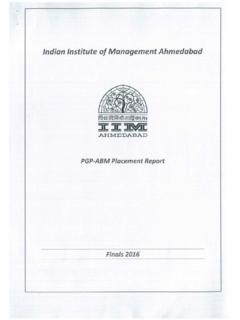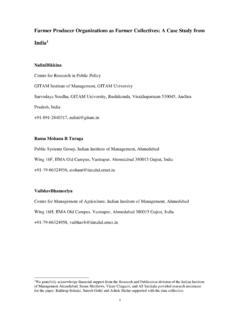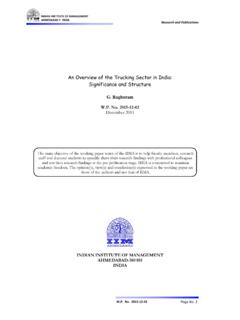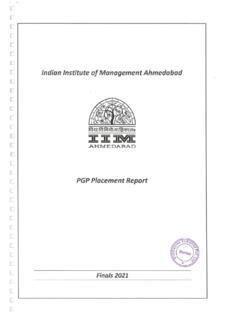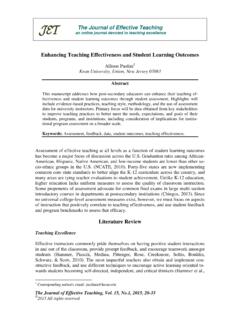Transcription of Diversity and Inclusion at the Workplace: A Review of ...
1 INDIAN INSTITUTE OF MANAGEMENT AHMEDABAD INDIA Research and Publications Diversity and Inclusion at the Workplace: A Review of Research and Perspectives Nisha Nair Neharika Vohra No. 2015-03-34 March 2015 The main objective of the working paper series of the IIMA is to help faculty members, research staff and doctoral students to speedily share their research findings with professional colleagues and test their research findings at the pre-publication stage. IIMA is committed to maintain academic freedom. The opinion(s), view(s) and conclusion(s) expressed in the working paper are those of the authors and not that of IIMA. INDIAN INSTITUTE OF MANAGEMENT AHMEDABAD-380 015 INDIA No. 2015-03-34 Page No. 2 Diversity and Inclusion at the Workplace: A Review of Research and Perspectives Nisha Nair Cotsakos College of Business William Patterson University, New Jersey Neharika Vohra Indian Institute of Management, Ahmedabad Abstract In recent years, the discourse on Diversity has seen a shift to that of Inclusion .
2 While there is a rich body of research in the area of Diversity , Inclusion has emerged as a fairly recent area of exploration and the varied meanings and interpretations of the terms make it ripe for examining the literature on Diversity and that of Inclusion to offer a deeper and nuanced understanding of their meanings and conceptualizations. This Review in attempting to do the same also examines the intersectionalities of leadership with Diversity and Inclusion , and offers insights for taking the research forward. No. 2015-03-34 Page No. 3 Contents Diversity and Inclusion at the Work Place: A Review of Research and Perspectives ..4 Introduction ..4 Scope and Coverage ..4 Understanding Diversity ..5 Diversity Perspectives ..5 Advantages of Diversity ..6 Linkages to Success ..7 Negative Outcomes of Working with Diversity .
3 8 Common Diversity and Inclusion Initiatives ..9 Understanding Inclusion .. 10 From Diversity to Inclusion .. 10 Distinct but Interrelated Concepts .. 10 Context of Inclusion in India .. 10 Evolving Definitions of Inclusion .. 12 Theoretical Underpinnings of 13 The Psychology of Inclusion .. 15 Drivers and Outcomes of Inclusion .. 17 Climate of Inclusion .. 18 leadership and Inclusion .. 19 Understanding how Inclusive leadership Works .. 19 Creating Inclusive Workplaces .. 22 Future Agenda for Inclusion .. 24 Conclusion .. 26 Bibliography .. 27 About the Authors .. 36 No. 2015-03-34 Page No. 4 Diversity and Inclusion at the Work Place: A Review of Research and Perspectives Introduction Having a diverse workforce is increasingly being recognized as instrumental in improving the firm s performance, and also an imperative that organizations can no longer choose to ignore.
4 It is well recognized today that Diversity adds both tangible and intangible value, even if it requires working through the issues and costs that sometimes accompany it. What we see today is the discourse increasingly shifting to one of Inclusion , over and beyond that of Diversity . Empirical studies on organizational practices of Inclusion are somewhat limited, barring a few [1, 2]. This is understandable since Inclusion has only recently entered the lexicon of popular discourse. Areas of organizational practices for Inclusion have been related to recruitment and selection, training and development and socialization activities like meals and parties [1]. A more encompassing examination of sustained inclusive practices, approaches and measures is still largely missing. Perceptions of Inclusion are often referential to an assumed mainstream in an organization.
5 Few studies have looked at the experience of Inclusion from the point of view of the privileged in the equation [3]. Fewer have examined Inclusion from the point of view of other less common demographics of interest in the Diversity literature, such as that of migrants [1]. Scope and Coverage This Review focuses on understanding Diversity and Inclusion and reflecting on questions around them, in addition to clarifying the meanings and interpretations of the terms associated with it. What exactly do Diversity and Inclusion mean? What influences Diversity and Inclusion and what do we know about research regarding them? What are the fault lines in managing issues around them? What role do leadership and organizational climate play in shaping them? No. 2015-03-34 Page No. 5 Understanding Diversity The term Diversity is often used to describe: The composition of work groups Demographic differences Emphasis on Diversity focuses on the composition of work groups around factors that generally distinguishes one individual from the other, mostly in terms of observable demographic characteristics such as gender, race, ethnicity, or age, or in term of non-observable attributes such as education or socio-economic status [4, 5].
6 Definition of Diversity : As may be expected there are various definitions of Diversity . Some of the common definitions include : The mixture of attributes within a workforce that in significant ways affect how people think, feel, and behave at work, and their acceptance, work performance, satisfaction, or progress in the organization [6]. Diversity has also been described [7] as the varied perspectives and approaches to work members of different identity groups bring . While demographic Diversity may be a visible lead indicator, Diversity of thought is seen as the end game [8]. Diversity Perspectives Initially, the business case for Diversity was built on the assumption that women and minorities would outnumber the traditional white male worker, and since this was a foreseeable future, businesses were left with no choice but to learn to manage a diverse workforce productively [9].
7 Organizations in the United States are legally bound to support Diversity , owing in part to the US Civil Rights Act of 1964, affirmative action and equal employment opportunity [10]. Since the initial focus in the 1980s on women and people of color, the meaning of Diversity has expanded to include other forms of demographics such as religious practices and sexual orientation. Diversity and Inclusion in the current context encompass other invisible forms of differences among people that include factors such as educational background, functional specialties, working styles, thinking styles and even personality traits [11, 12]. Some [13] argue that when Diversity efforts focus more on visual identities such as race, gender, age or disability, without addressing hidden identities emergent from differences in values, beliefs, attitudes, cultures or needs, it may actually hinder development of inclusive cultures by overemphasizing differences rather than commonalties.
8 No. 2015-03-34 Page No. 6 Different Diversity perspectives have been proposed [14, 15]. According to the typologies proposed, they can vary from a negative view of Diversity marked by resistance ( Diversity as a threat) to more positive approaches such as - Discrimination and fairness perspective (differences problematized): Involves focus on justice and the fair treatment of all members, as a moral imperative. Access and legitimacy perspective (where differences are thought to create opportunities such as access to new markets or consumers): Based on the recognition that the organization s markets and constituencies are culturally diverse and therefore matching the organization s own workforce is a way of gaining access and legitimacy to those markets. Learning and integration perspective (seen as offering opportunities and providing sustained benefits in the long run): Premised on the belief that the skills, experiences and insights of diverse employees is a potentially valuable resource for learning and change, and is valued in the workgroup for attainment of its goals While there are very tangible reasons for promoting Diversity and Inclusion , and often a business case has to be made to make the argument more compelling, it is also, simply put, the right thing to do.
9 As observed [16], there are multiple reasons for investing in Diversity , not the least of which is because it is ethically and morally the right thing to do. Advantages of Diversity Diversity can provide many potential advantages to organizations. On one level it helps organizations to reach out to diverse customer groups and markets, and on another level by allowing for a variety of perspectives, it promotes innovativeness and superior work outcomes and performance. In one study of Fortune 500 companies, it was found that the top 25% of the firms in terms of women in senior management, actually yielded returns to their stockholders that were more than 30% higher than those of their peers [17]. Based on empirical evidence it is argued [18] that Diversity does in fact pay. A survey in the United States [18] found racial Diversity to be associated with increased sales revenue, more number of customers, greater market share, and greater relative profits.
10 Gender No. 2015-03-34 Page No. 7 Diversity was associated with increased sales revenue and customers, and greater relative profit. The findings that more women as board members translates to higher financial returns, was based on a study commissioned by the Times of India group [19] to examine the relationship between companies with women on their boards and profitability. Using the top Indian 100 companies as listed on the Bombay Stock Exchange, the study reports a positive impact of women representation in top leadership and as board members, on ROE. In a report by Deloitte it is argued that Diversity and Inclusion lead to improved business outcomes and Diversity means more than just having a sprinkle of women and a dab of color [8]. Diversity management alone is insufficient to improve performance [20]. Inclusive workplaces characterized by supportive leadership and empowered employees is required to translate the gains.

